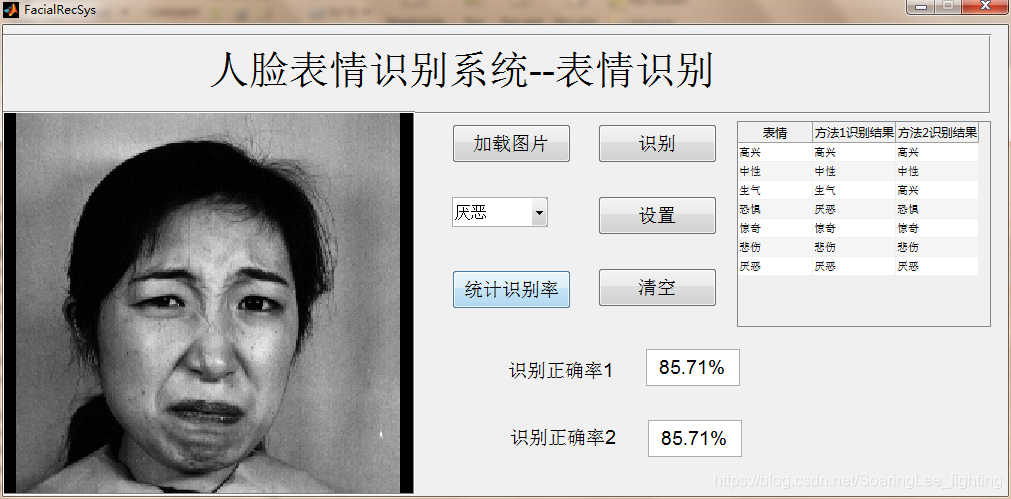【毕业设计专栏】007:基于PCA和SVM的表情识别matlab GUI系统设计
DATE: 2021-05-29
本人提供付费咨询服务并长期承接各类毕设项目以及外包项目。联系QQ: 2963033731 加Q备注:CSDN 外包
1、前言
在大学毕业设计时,实现了一种基于PCA和SVM的表情识别系统,提取特征值,并与数据库里的模板相匹配,从而识别表情,准确率可以达到85%。效果如下所示:
2、表情识别效果
若需要相关代码可以在关注和订阅博主专栏之后,加博主QQ(2963033731)索取(代码付费提供)。
2.1、训练

2.2、测试

3、部分Matlab代码
function varargout = FacialRecSysLearn(varargin)
% FACIALRECSYSLEARN M-file for FacialRecSysLearn.fig
% FACIALRECSYSLEARN, by itself, creates a new FACIALRECSYSLEARN or raises the existing
% singleton*.
%
% H = FACIALRECSYSLEARN returns the handle to a new FACIALRECSYSLEARN or the handle to
% the existing singleton*.
%
% FACIALRECSYSLEARN('CALLBACK',hObject,eventData,handles,...) calls the local
% function named CALLBACK in FACIALRECSYSLEARN.M with the given input arguments.
%
% FACIALRECSYSLEARN('Property','Value',...) creates a new FACIALRECSYSLEARN or raises the
% existing singleton*. Starting from the left, property value pairs are
% applied to the GUI before FacialRecSysLearn_OpeningFcn gets called. An
% unrecognized property name or invalid value makes property application
% stop. All inputs are passed to FacialRecSysLearn_OpeningFcn via varargin.
%
% *See GUI Options on GUIDE's Tools menu. Choose "GUI allows only one
% instance to run (singleton)".
%
% See also: GUIDE, GUIDATA, GUIHANDLES
% Edit the above text to modify the response to help FacialRecSysLearn
% Last Modified by GUIDE v2.5 13-Nov-2016 15:47:45
% Begin initialization code - DO NOT EDIT
gui_Singleton = 1;
gui_State = struct('gui_Name', mfilename, ...
'gui_Singleton', gui_Singleton, ...
'gui_OpeningFcn', @FacialRecSysLearn_OpeningFcn, ...
'gui_OutputFcn', @FacialRecSysLearn_OutputFcn, ...
'gui_LayoutFcn', [] , ...
'gui_Callback', []);
if nargin && ischar(varargin{1})
gui_State.gui_Callback = str2func(varargin{1});
end
if nargout
[varargout{1:nargout}] = gui_mainfcn(gui_State, varargin{:});
else
gui_mainfcn(gui_State, varargin{:});
end
% End initialization code - DO NOT EDIT
% --- Executes just before FacialRecSysLearn is made visible.
function FacialRecSysLearn_OpeningFcn(hObject, eventdata, handles, varargin)
% This function has no output args, see OutputFcn.
% hObject handle to figure
% eventdata reserved - to be defined in a future version of MATLAB
% handles structure with handles and user data (see GUIDATA)
% varargin command line arguments to FacialRecSysLearn (see VARARGIN)
% Choose default command line output for FacialRecSysLearn
handles.output = hObject;
% Update handles structure
guidata(hObject, handles);
% UIWAIT makes FacialRecSysLearn wait for user response (see UIRESUME)
% uiwait(handles.figure1);
% --- Outputs from this function are returned to the command line.
function varargout = FacialRecSysLearn_OutputFcn(hObject, eventdata, handles)
% varargout cell array for returning output args (see VARARGOUT);
% hObject handle to figure
% eventdata reserved - to be defined in a future version of MATLAB
% handles structure with handles and user data (see GUIDATA)
% Get default command line output from handles structure
varargout{1} = handles.output;
% --- Executes on button press in loaddb_btn.
function loaddb_btn_Callback(hObject, eventdata, handles)
% hObject handle to loaddb_btn (see GCBO)
% eventdata reserved - to be defined in a future version of MATLAB
% handles structure with handles and user data (see GUIDATA)
global P_train;
global train_label;
addpath train;
mapping=getmapping(8,'u2');%LBP映射
W=[2,1,1,1,1,1,2; ...
2,4,4,1,4,4,2; ...
1,1,1,0,1,1,1; ...
0,1,1,0,1,1,0; ...
0,1,1,1,1,1,0; ...
0,1,1,2,1,1,0; ...
0,1,1,1,1,1,0];
facialkind={'悲伤','高兴','惊奇','恐惧','生气','厌恶','中性'};
templates=[];
train_label=[];
c=[];
for k=1:size(facialkind,2);
path = sprintf('train\\%s\',(facialkind{k}));
DIRS = dir(path);
n=length(DIRS);
dirinfo='';
for i=1:n
if (~DIRS(i).isdir && ~strcmp(DIRS(i).name,'.') && ~strcmp(DIRS(i).name,'..') )
dirinfo=strvcat(dirinfo,DIRS(i).name);
end
end
for www=1:size(dirinfo,1)
file=sprintf('%s\\%s',path,dirinfo(www,:));
templates{www}=imread(file);
axes(handles.axes1);
imshow( templates{www},[])
train_label=[train_label k];
X = double(templates{www});
X = imresize(X,[128 128],'bilinear'); %采用'bilinear':采用双线性插值算法扩展为128*128
H2=DSLBP(X,mapping,W);%提取图片的LBP直方图
Gray=X;
Gray=(Gray-mean(Gray(:)))/std(Gray(:))*20+128;
lpqhist=lpq(Gray,3,1,1,'nh'); %计算每个照片lpq直方图
a=[H2,lpqhist];
c=[c;a];%LPB和LPQ特征融合
pause(0.01);
end
end
P_train=c;
P_train=mapminmax(P_train,0,1);
% --- Executes on button press in pushbutton2.
function pushbutton2_Callback(hObject, eventdata, handles)
% hObject handle to pushbutton2 (see GCBO)
% eventdata reserved - to be defined in a future version of MATLAB
% handles structure with handles and user data (see GUIDATA)
global P_train;
global train_label;
%%%%%从这里开始是识别表情的算法,使用支持向量机来识别
addpath SVM-KM %%添加支持向量机工具箱
c = 100;
lambda = 1e-7;
kerneloption= 1.3; %设置核参数
kernel='gaussian'; %设置高斯核作为支持向量机的核函数
verbose = 0;
nbclass=7;
[xsup,w,b,nbsv]=svmmulticlassoneagainstall(P_train,train_label',nbclass,c,lambda,kernel,kerneloption,verbose); %使用支持向量机进行训练获得支持向量
[ypred1,maxi] = svmmultival(P_train,xsup,w,b,nbsv,kernel,kerneloption); %训练集测试
save('svmdata', 'xsup', 'w', 'b','nbsv');
% --- Executes on button press in pushbutton3.
function pushbutton3_Callback(hObject, eventdata, handles)
% hObject handle to pushbutton3 (see GCBO)
% eventdata reserved - to be defined in a future version of MATLAB
% handles structure with handles and user data (see GUIDATA)
facialkind={'悲伤','高兴','惊奇','恐惧','生气','厌恶','中性'};
templates=[];
train_label=[];
c=[];
imageSize = [280,180]; % All Images are resized into a common size
numImage=7*20;
img = zeros(imageSize(1)*imageSize(2),numImage);
index=1;
T=[];
for k=1:size(facialkind,2);
path = sprintf('train\\%s\',(facialkind{k}));
DIRS = dir(path);
n=length(DIRS);
dirinfo='';
for i=1:n
if (~DIRS(i).isdir && ~strcmp(DIRS(i).name,'.') && ~strcmp(DIRS(i).name,'..') )
dirinfo=strvcat(dirinfo,DIRS(i).name);
end
end
for www=1:size(dirinfo,1)
file=sprintf('%s\\%s',path,dirinfo(www,:));
pic=imread(file);
img=imresize(pic,imageSize);
[irow icol] = size(img);
temp = reshape(img',irow*icol,1); % Reshaping 2D images into 1D image vectors
T = [T temp]; % 'T' grows after each turn
index=index+1;
axes(handles.axes1);
imshow(pic,[])
end
end
[m, A, Eigenfaces] = EigenfaceCore(T);
save('pcadata', 'm','A','Eigenfaces');
---------------------------------------------THE END!-----------------------------------------------------------
本文为博主原创文章,未经博主允许不得转载。若允许转载,请注明来源https://www.cnblogs.com/SoaringLee/,否则保留追究法律责任的权利!
另外,本人提供付费咨询服务并长期承接各类毕设以及外包项目。联系QQ:2963033731。加Q备注:CNBLOG外包





【推荐】国内首个AI IDE,深度理解中文开发场景,立即下载体验Trae
【推荐】编程新体验,更懂你的AI,立即体验豆包MarsCode编程助手
【推荐】抖音旗下AI助手豆包,你的智能百科全书,全免费不限次数
【推荐】轻量又高性能的 SSH 工具 IShell:AI 加持,快人一步
· 10年+ .NET Coder 心语,封装的思维:从隐藏、稳定开始理解其本质意义
· .NET Core 中如何实现缓存的预热?
· 从 HTTP 原因短语缺失研究 HTTP/2 和 HTTP/3 的设计差异
· AI与.NET技术实操系列:向量存储与相似性搜索在 .NET 中的实现
· 基于Microsoft.Extensions.AI核心库实现RAG应用
· 10年+ .NET Coder 心语 ── 封装的思维:从隐藏、稳定开始理解其本质意义
· 地球OL攻略 —— 某应届生求职总结
· 提示词工程——AI应用必不可少的技术
· Open-Sora 2.0 重磅开源!
· 周边上新:园子的第一款马克杯温暖上架